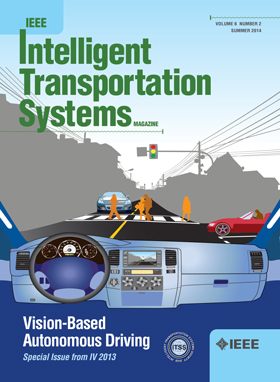Self-Supervised Transformer for Trajectory Prediction Using Noise Imputed Past Trajectory
IF 8.4
1区 工程技术
Q1 ENGINEERING, CIVIL
IEEE Transactions on Intelligent Transportation Systems
Pub Date : 2025-04-14
DOI:10.1109/TITS.2025.3550711
引用次数: 0
Abstract
Trajectory prediction is one of the important components for achieving higher levels of Society of Automotive Engineers (SAE) driving automation, enabling them to navigate through complex driving scenarios and make informed decisions in unexplored roads. Problems such as the varying behaviour of drivers on the road, sensor measurement inaccuracies, and dense and complex environmental circumstances make this task difficult. To address these challenges, a self-supervised transformer (SST) framework is proposed. The noise-imputed trajectory points for road agents are generated. This enhances the model’s ability to handle uncertain data. A self-supervised task is proposed, which focuses on predicting past trajectory points using both true and noise-imputed trajectory encoded features. This approach highlights the important patterns or connections in the data that could go unnoticed if supervised tasks were the only one used. Further, in addition to the trajectory prediction task, a consistent loss function should be introduced to preserve spatial consistency with noise imputed trajectory points. Moreover, learnable query embeddings are added to the system to improve the diversity of multi-modal predictions. The SST model has been evaluated on the widely used and recent Argoverse 2 dataset and outperforms state-of-the-art models by a margin of 2.17%-24.15%, 5.38%-30.05%, 9.41%-46.89% and 0.20%-21.21% on the minADE6, minFDE6, MR6 and b-FDE6 respectively.基于噪声的自监督变压器轨迹预测
轨迹预测是实现汽车工程师协会(SAE)更高水平驾驶自动化的重要组成部分之一,使他们能够在复杂的驾驶场景中导航,并在未开发的道路上做出明智的决策。诸如驾驶员在道路上的不同行为、传感器测量的不准确性以及密集和复杂的环境等问题使这项任务变得困难。为了解决这些挑战,提出了一种自监督变压器(SST)框架。生成了道路代理的噪声输入轨迹点。这增强了模型处理不确定数据的能力。提出了一种自监督任务,该任务的重点是使用真实和噪声输入的轨迹编码特征来预测过去的轨迹点。这种方法突出了数据中的重要模式或连接,如果只使用监督任务,这些模式或连接可能会被忽视。此外,除了弹道预测任务外,还应引入一致损失函数以保持与噪声输入轨迹点的空间一致性。此外,在系统中加入了可学习的查询嵌入,以提高多模态预测的多样性。在广泛使用和最新的Argoverse 2数据集上对SST模型进行了评估,在minADE6、minFDE6、MR6和b-FDE6上,SST模型分别优于最先进的模型2.17%-24.15%、5.38%-30.05%、9.41%-46.89%和0.20%-21.21%。
本文章由计算机程序翻译,如有差异,请以英文原文为准。
求助全文
约1分钟内获得全文
求助全文
来源期刊

IEEE Transactions on Intelligent Transportation Systems
工程技术-工程:电子与电气
CiteScore
14.80
自引率
12.90%
发文量
1872
审稿时长
7.5 months
期刊介绍:
The theoretical, experimental and operational aspects of electrical and electronics engineering and information technologies as applied to Intelligent Transportation Systems (ITS). Intelligent Transportation Systems are defined as those systems utilizing synergistic technologies and systems engineering concepts to develop and improve transportation systems of all kinds. The scope of this interdisciplinary activity includes the promotion, consolidation and coordination of ITS technical activities among IEEE entities, and providing a focus for cooperative activities, both internally and externally.
 求助内容:
求助内容: 应助结果提醒方式:
应助结果提醒方式:


